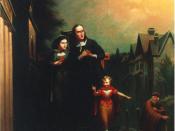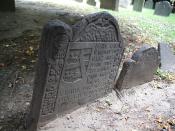The Scarlet Letter by Nathaniel Hawthorne is a personal account of a Puritan woman, who is being tried for a sinful crime. This timeless classic, which is full of adultery, betrayal, promiscuity, subterfuge, and intrigue, would make a great coming attraction for a Hollywood movie not to mention a great storyline for this book. This literally masterpiece is set back in seventeenth-century Boston; this setting is the main character's problem because if it was set in today's time, there would be no problem with this sinful act. Hawthorne recounts the tragic life of Hester Prynne, which is full of hardships, mystery, and betrayal.
Hester's life was a long and twisty road, but in that day in time she deserved ever bit of pain and despair that she could bare. Hester Prynne had an affair outside of her marriage, which is called adultery, and gave birth to a child from this sinful act.
Hester was forced to stand on a scaffold for hours with her daughter Pearl because of her act of adultery, but I would say that the real hardship for Hester was that nobody had enough courage to stand with her. Neither her husband nor her mysterious lover had enough guts to face their problems up front, so because of this Hester was alone. Her husband was too afraid of ruining is social image to admit to being married to such a woman, but he and Hester made a deal. The deal was that if she didn't tell that he was her husband then he would not harm her lover, who is at this time is still unknown but to the author. So the idea was made, and they went their separate ways, but still Hester was alone and depressed.
Mystery was an excellent addition to this novel because Hawthorne knew when to keep things a secret until the right time. During the beginning of this book, a dark, deformed character enters the yelling crowd, that is torturing Hester with cruel and brutal words. This mysterious man ends up being Hester's husband, Roger Chillingworth. At first, you have to feel sorry for this man because he has just came back from being held captive by Indians, and when he returns to civilization ,so to speak, he sees his wife, standing on the scaffold. Then he gets anger because he notices that the baby she is holding is not his but his wife's lover's baby. This is just one instance of mystery in this great novel.
Another mystery in the novel was the identity of her secret lover. The secret lover was none other than the respectable minister, Reverend Arthur Dimmesdale. Arthur was a young, and I guess you could call him a physically delicate man because he seemed to stay sick or always having something physically wrong with him. He was also very well educated and there was no doubt that he was a servant of God, but he had one character flaw. This character flaw was that he could not publicly announce his affair with Hester. He decided to just keep it stashed away somewhere, but what he did not know was that this particular sin was too big for him to hide. This act caused Dimmesdale's conscience to work overtime because he thought that since he is a minister that he was supposed to be pure and getting everyone around him to confess their sins, and here he was concealing his own sin of adultery. The real question to be concern about is why. Why does Dimmesdale conceal this sin? Well, the only answer that comes to my mind is in Chapter 10 when Dimmesdale himself offers a little light on this subject. He says, " It may be that they are kept silent by the very constitution of their nature. Or-can we not suppose it-guilty as they may be, retaining , nevertheless, a zeal for God's glory and man's welfare, they shrink from displaying themselves black and filthy in the view of men; because, thenceforward, no good can be achieved by them; no evil of the past be redeemed by better service." This novel is also full of betrayal. Can you guess who it is that gives up? Well if you have not guessed by now, I will just tell you. Dimmesdale could not control his conscience nor his sin anymore so he went one day to the scaffold were Hester and Pearl stood. When he called for help from Hester to assist him in getting up on the scaffold, the doctor, Roger Chillingworth, tried to stop Dimmesdale, but Dimmesdale just turned and yelled at him to get away. Then Dimmesdale tells Hester that he is dying and he can not die with his sin still concealed from the world. Then he yells to the crowd, "I also bear a letter of sin but it is unseen to the eye but not unfelt to the heart" ,and for a moment he stood there tall and strong, then he falls because he is so weak. Hester bends down and cradles Dimmesdale, but the whole time Chillingworth is repeating, "Thou hast escaped me!" Dimmesdale's last words were "Praised be his name! His will be done! Farewell!", then he was gone. Dimmesdale may have betrayed Hester by not keeping his sin concealed, but before death he was true to himself. Even in death, Dimmesdale was too much a Puritan to control his own afterlife; he lives his fate up to God.
There was no conclusion for me to this book because Hawthorne used the method of talking about moralization for the last chapter. This technique really irritates me, but back in Hawthorne's time this was a popular method. I guess I could talk about the symbolism. Pearl, for instance, symbolized lots of things. Although Hester had so much trouble with Pearl, she still felt that Pearl was her treasure. Pearl was really the only thing that Hester had in life, and if Pearl was not in Hester's life then Hester almost have surely committed suicide. Once and a while, Pearl would bring joy to Hester's life, and that helped her keep living. Pearl really symbolized a rose to her mother because at times she could be bright and vibrant, and really love her mother, but at other times, she could be wilting. It was at these times when she was "wilting" that brought Hester the most grief. One final way that Pearl symbolized something in the novel was with her association with the scarlet letter. Pearl really was the scarlet letter, because if Pearl had never been born then Hester would have never been found guilty of adultery, and then she would never have to wear that burden upon her chest. Without that burden, Hester would have led a much better life than the one she had throughout the novel. In closing, Pearl was a source of many different kinds of symbolism. From being a rose, to representing the scarlet letter "A", she was kind of a burden, yet a love for Hester. As a final note, Pearl was more than her mother's only treasure; she was her mother's only source of survival. They were many accounts of symbolism. I would have talked about them all, but this is not a research paper.
Overall, this novel was exceptional, but at other times this book was boring and time consuming. Hawthorne uses suspense, mystery and creativity to its fullest. The message he conveys makes the reader think about things in a deeper way sometimes without even realizes it. Through this utilization of symbolism the reader is given a deeper look into the dynamics of the characters, Puritan society, and in several cases life itself. Unfortunately, sometimes it seems as though by expanding the symbolism of The Scarlet Letter umpteenth times that he wears it out so the reader wants nothing more to do with the dumb "A" on some woman's chest hundreds of years ago. Sadly, it seems as though Hawthorne found himself a rather large thesaurus and added a bunch of mindless prattle that mellowed out the high points of the book and expanded on the low points. In many chapters, all he managed to accomplish is to update the lives of the characters, mostly by irrelevant drivel. Other than these comments, it was rather good book.





